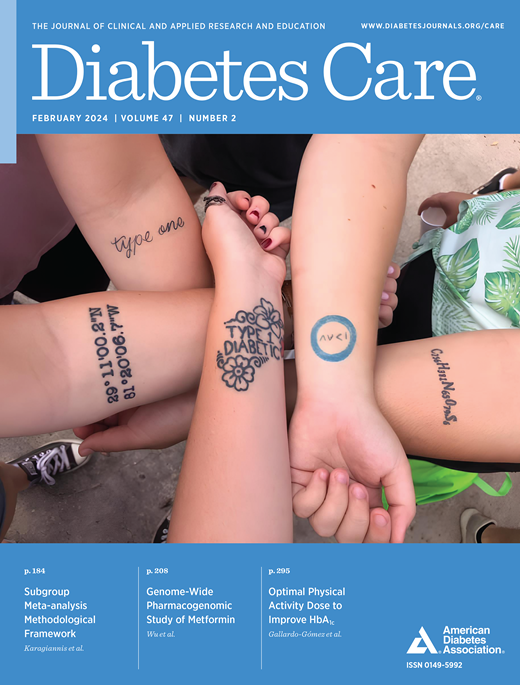DNA Methylation Smoking Scores and Risk of Islet Autoimmunity and Type 1 Diabetes
IF 16.6
1区 医学
Q1 ENDOCRINOLOGY & METABOLISM
引用次数: 0
Abstract
OBJECTIVE Multiple studies have reported an inverse association between self-reported smoking during pregnancy and offspring type 1 diabetes (T1D) risk. We investigated the association between DNA methylation (DNAm) smoke exposure scores, parental self-reported smoking, and islet autoimmunity (IA) and T1D risk in children at high risk of T1D. RESEARCH DESIGN AND METHODS We used longitudinal data from the Diabetes Autoimmunity Study in the Young cohort, including 205 IA case and 206 control participants (87 and 88 were T1D case and control participants, respectively), matched by age, race/ethnicity, and sample availability. DNAm profiles were obtained from cord or peripheral blood using the Infinium Human Methylation 450K or EPIC BeadChip. Three published DNAm smoking scores were calculated at every time point. To estimate in utero smoke exposure, participant-specific intercepts were derived from mixed-effects models of longitudinal DNAm scores. These intercepts strongly correlated with cord blood scores (r = 0.85–0.95; n = 179), indicating their utility as proxies for in utero smoke exposure. Associations with IA/T1D were evaluated using logistic regression, adjusting for HLA-DR3/4, first-degree relative status, and sex. RESULTS Multivariable models showed both maternally reported smoking during pregnancy and higher DNAm smoking scores to be associated with lower risk of IA and T1D. Maternal smoking showed a strong inverse association with IA (odds ratio [OR] 0.24; 95% CI 0.10–0.54). Rauschert and McCartney DNAm scores showed consistent inverse associations with both outcomes (OR 0.65–0.83 for SD increase). CONCLUSIONS Our study supports existing literature indicating in utero smoke exposure is associated with reduced IA and T1D risk. Further research is essential to uncover the underlying mechanisms.DNA甲基化吸烟评分与胰岛自身免疫和1型糖尿病的风险
目的:多项研究报道了妊娠期间自我报告吸烟与后代1型糖尿病(T1D)风险之间的负相关关系。我们调查了DNA甲基化(DNAm)烟雾暴露评分、父母自我报告吸烟、胰岛自身免疫(IA)和T1D高风险儿童T1D风险之间的关系。研究设计和方法我们使用了来自年轻队列糖尿病自身免疫研究的纵向数据,包括205例IA患者和206例对照受试者(分别为87例和88例T1D患者和对照受试者),根据年龄、种族/民族和样本可用性进行匹配。使用Infinium Human Methylation 450K或EPIC BeadChip从脐带或外周血中获得dna谱。在每个时间点计算三个公布的DNAm吸烟评分。为了估计子宫内的烟雾暴露,参与者特定的拦截来自纵向DNAm评分的混合效应模型。这些截距与脐带血评分密切相关(r = 0.85-0.95;N = 179),表明它们作为子宫内烟雾暴露的代理的效用。在调整HLA-DR3/4、一级相对地位和性别后,采用logistic回归评估IA/T1D的相关性。结果多变量模型显示,母亲在怀孕期间报告吸烟和较高的DNAm吸烟评分与较低的IA和T1D风险相关。母亲吸烟与IA呈强烈的负相关(优势比[OR] 0.24;95% ci 0.10-0.54)。Rauschert和McCartney DNAm评分与两种结果呈一致的负相关(SD增加的OR为0.65-0.83)。结论:我们的研究支持现有文献,表明子宫内吸烟暴露与IA和T1D风险降低相关。进一步的研究对于揭示潜在的机制至关重要。
本文章由计算机程序翻译,如有差异,请以英文原文为准。
求助全文
约1分钟内获得全文
求助全文
来源期刊

Diabetes Care
医学-内分泌学与代谢
CiteScore
27.80
自引率
4.90%
发文量
449
审稿时长
1 months
期刊介绍:
The journal's overarching mission can be captured by the simple word "Care," reflecting its commitment to enhancing patient well-being. Diabetes Care aims to support better patient care by addressing the comprehensive needs of healthcare professionals dedicated to managing diabetes.
Diabetes Care serves as a valuable resource for healthcare practitioners, aiming to advance knowledge, foster research, and improve diabetes management. The journal publishes original research across various categories, including Clinical Care, Education, Nutrition, Psychosocial Research, Epidemiology, Health Services Research, Emerging Treatments and Technologies, Pathophysiology, Complications, and Cardiovascular and Metabolic Risk. Additionally, Diabetes Care features ADA statements, consensus reports, review articles, letters to the editor, and health/medical news, appealing to a diverse audience of physicians, researchers, psychologists, educators, and other healthcare professionals.
 求助内容:
求助内容: 应助结果提醒方式:
应助结果提醒方式:


